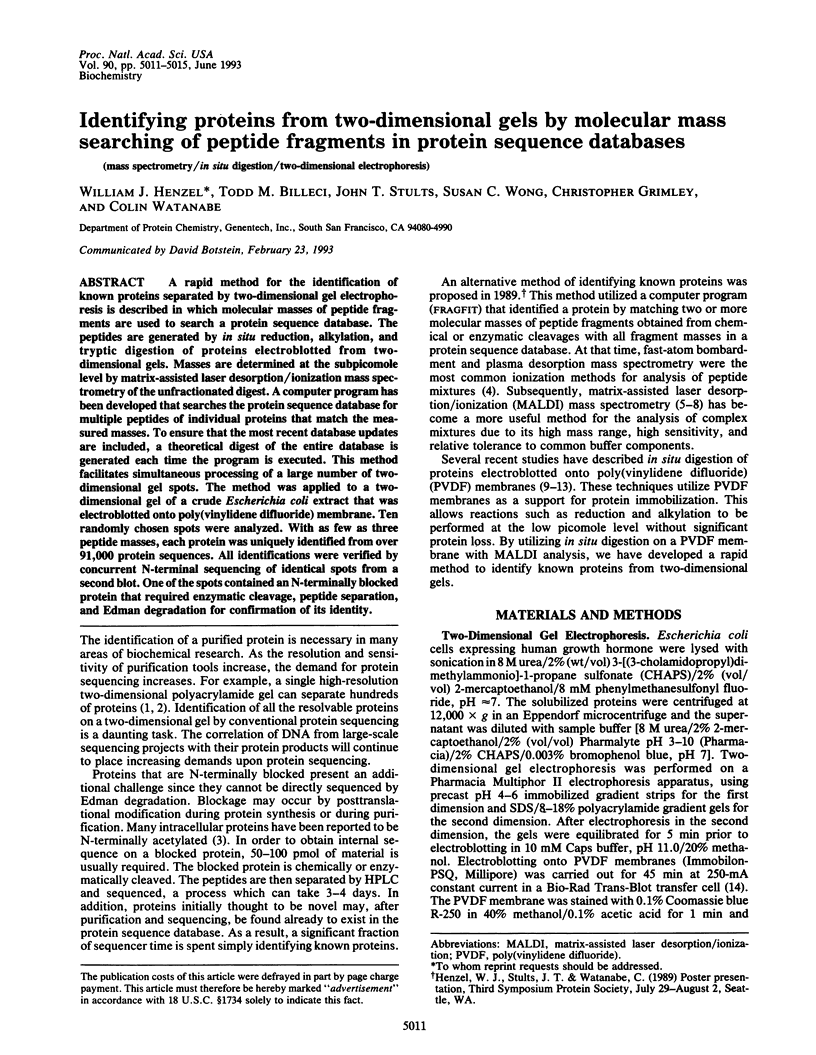Identifying proteins from two-dimensional gels by molecular mass searching of peptide fragments in protein sequence databases (original) (raw)
Abstract
A rapid method for the identification of known proteins separated by two-dimensional gel electrophoresis is described in which molecular masses of peptide fragments are used to search a protein sequence database. The peptides are generated by in situ reduction, alkylation, and tryptic digestion of proteins electroblotted from two-dimensional gels. Masses are determined at the subpicomole level by matrix-assisted laser desorption/ionization mass spectrometry of the unfractionated digest. A computer program has been developed that searches the protein sequence database for multiple peptides of individual proteins that match the measured masses. To ensure that the most recent database updates are included, a theoretical digest of the entire database is generated each time the program is executed. This method facilitates simultaneous processing of a large number of two-dimensional gel spots. The method was applied to a two-dimensional gel of a crude Escherichia coli extract that was electroblotted onto poly(vinylidene difluoride) membrane. Ten randomly chosen spots were analyzed. With as few as three peptide masses, each protein was uniquely identified from over 91,000 protein sequences. All identifications were verified by concurrent N-terminal sequencing of identical spots from a second blot. One of the spots contained an N-terminally blocked protein that required enzymatic cleavage, peptide separation, and Edman degradation for confirmation of its identity.

Images in this article
Selected References
These references are in PubMed. This may not be the complete list of references from this article.
- Bauw G., Van Damme J., Puype M., Vandekerckhove J., Gesser B., Ratz G. P., Lauridsen J. B., Celis J. E. Protein-electroblotting and -microsequencing strategies in generating protein data bases from two-dimensional gels. Proc Natl Acad Sci U S A. 1989 Oct;86(20):7701–7705. doi: 10.1073/pnas.86.20.7701. [DOI] [PMC free article] [PubMed] [Google Scholar]
- Beavis R. C., Chait B. T. Rapid, sensitive analysis of protein mixtures by mass spectrometry. Proc Natl Acad Sci U S A. 1990 Sep;87(17):6873–6877. doi: 10.1073/pnas.87.17.6873. [DOI] [PMC free article] [PubMed] [Google Scholar]
- Fenn J. B., Mann M., Meng C. K., Wong S. F., Whitehouse C. M. Electrospray ionization for mass spectrometry of large biomolecules. Science. 1989 Oct 6;246(4926):64–71. doi: 10.1126/science.2675315. [DOI] [PubMed] [Google Scholar]
- Fernandez J., DeMott M., Atherton D., Mische S. M. Internal protein sequence analysis: enzymatic digestion for less than 10 micrograms of protein bound to polyvinylidene difluoride or nitrocellulose membranes. Anal Biochem. 1992 Mar;201(2):255–264. doi: 10.1016/0003-2697(92)90336-6. [DOI] [PubMed] [Google Scholar]
- Henzel W. J., Bourell J. H., Stults J. T. Analysis of protein digests by capillary high-performance liquid chromatography and on-line fast atom bombardment mass spectrometry. Anal Biochem. 1990 Jun;187(2):228–233. doi: 10.1016/0003-2697(90)90448-i. [DOI] [PubMed] [Google Scholar]
- Henzel W. J., Rodriguez H., Watanabe C. Computer analysis of automated Edman degradation and amino acid analysis data. J Chromatogr. 1987 Aug 28;404(1):41–52. doi: 10.1016/s0021-9673(01)86835-7. [DOI] [PubMed] [Google Scholar]
- Hillenkamp F., Karas M., Beavis R. C., Chait B. T. Matrix-assisted laser desorption/ionization mass spectrometry of biopolymers. Anal Chem. 1991 Dec 15;63(24):1193A–1203A. doi: 10.1021/ac00024a002. [DOI] [PubMed] [Google Scholar]
- Iwamatsu A. S-carboxymethylation of proteins transferred onto polyvinylidene difluoride membranes followed by in situ protease digestion and amino acid microsequencing. Electrophoresis. 1992 Mar;13(3):142–147. doi: 10.1002/elps.1150130129. [DOI] [PubMed] [Google Scholar]
- Matsudaira P. Sequence from picomole quantities of proteins electroblotted onto polyvinylidene difluoride membranes. J Biol Chem. 1987 Jul 25;262(21):10035–10038. [PubMed] [Google Scholar]
- Osterman A. L., Hood J. Synovectomy, arthroplasty, and arthrodesis in the reconstruction of the rheumatoid wrist and hand. Curr Opin Rheumatol. 1991 Feb;3(1):102–108. doi: 10.1097/00002281-199102000-00016. [DOI] [PubMed] [Google Scholar]
- Tsunasawa S., Sakiyama F. Amino-terminal acetylation of proteins: an overview. Methods Enzymol. 1984;106:165–170. doi: 10.1016/0076-6879(84)06016-x. [DOI] [PubMed] [Google Scholar]
- Yuen S. W., Chui A. H., Wilson K. J., Yuan P. M. Microanalysis of SDS-PAGE electroblotted proteins. Biotechniques. 1989 Jan;7(1):74–83. [PubMed] [Google Scholar]